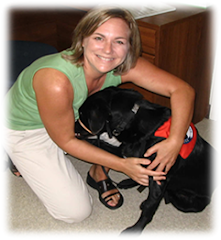
Clicker training is a wonderful activity that can be easily incorporated into a therapy session with a dog. Clicker training is based on positive reinforcement, and teaches the child not only positive reinforcement techniques, but also how to communicate your needs to another "creature". In this photo, Braydon is working with Chief to perfect the "high 5" behavior.
Braydon has weekly visits with Chief, and during his visits, his primary task is to work on behaviors Chief already knows to teaching him new behaviors. Braydon understands and is learning clicker training, and he is a natural trainer! The therapeutic reasons we use this type of treatment activity are vast. Braydon has difficulty with fine motor dexterity. Using a clicker encourages FM control. Being able to move a piece of dog treat from the palm of his hand to his finger (known as palm to finger translation--a hand skill) requires significant dexterity skills. While Braydon is able to perform this skill, it does take him significant time to perform. However, when an anxious dog is waiting for his reward, there is an increased motivation to speed up this skill.
Additionally, as you can see by the photo, Braydon has very high muscle tone in his lower extremities. This makes standing, walking, and balance challenging for him. His physical therapist (not seen here because she doesn't like her photo taken..LOL) is facilitating correct standing posture while Braydon balances on the foam pad. Dynamic standing balance, which is applying movement during a functional task such as standing, is difficult for Braydon as well. So, I try to get him to work on behaviors that involve bending over, movement of his upper extremities, etc. to incorporate a dynamic component to this task.
Braydon also has difficulty managing frustration. Chief is the PERFECT match for Braydon, because he has this difficulty as well! When Chief is frustrated during training, he gets a little "mouthy" and will whine or vocalize a bit. Braydon has learned this is cue to help alleviate Chief's frustration by reducing the expectation or help him more. This cue is good for Braydon because it teaches him to also ask for assistance. If he doesn't know how to get Chief to do something, and himself becomes frustrated, he will look to me for guidance rather than have a "meltdown" (as was previously typical).
So, if you are looking for different activities that you can do with your dog during therapy visits, consider involving the patient in your dog's training process. It can be a learning, as well as therapeutic, experience for all!!



No comments:
Post a Comment